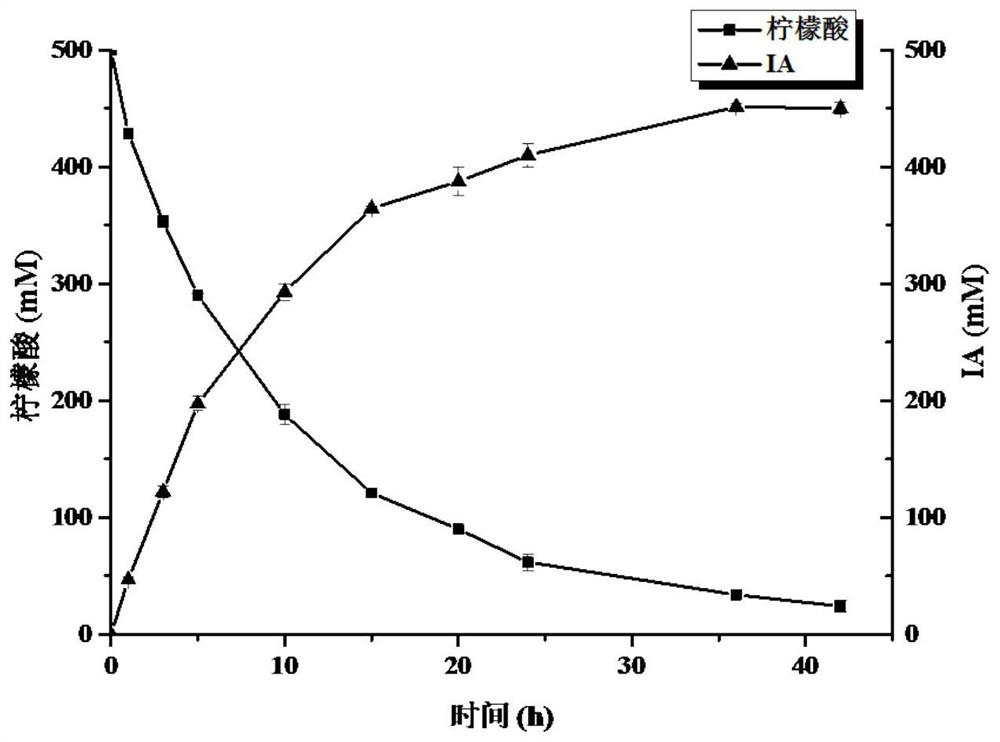Recombinant halomonas, construction method of recombinant halomonas and application of recombinant halomonas in preparation of itaconic acid by catalyzing citric acid
A technology of halophilic bacterium and construction method, which is applied in the field of recombinant halophilic bacterium and its construction method and the application field of cell catalyzed citric acid to prepare itaconic acid, which can solve the problems such as no modified halophilic bacterium , to achieve the effect of mild conditions, high efficiency and short reaction cycle
- Summary
- Abstract
- Description
- Claims
- Application Information
AI Technical Summary
Problems solved by technology
Method used
Image
Examples
Embodiment 1
[0049] Example 1 Construction of Halomonas Chassis Cells
[0050] In the wild-type Halomonas sp.TD01 (preserved in the General Microbiology Center of the China Microbiological Culture Collection Management Committee on November 19, 2010, the preservation registration number is CGMCC No.4353, and the preservation address: Chaoyang District, Beijing No. 3, No. 1 Yard, Beichen West Road) integrated the Mmp1 RNA polymerase expression unit into the genome to obtain Halomonassp.TD1.0;
[0051] Then replace the start codon ATG of the isocitrate dehydrogenase coding gene icd on the Halomonas sp.TD1.0 genome with TTG to obtain Halomonas sp.TD2.0;
[0052] The nucleotide sequence of the isocitrate dehydrogenase encoding gene icd is shown in SEQ ID NO.1;
[0053] Specifically include the following steps:
[0054] (1) Integrate the Mmp1 RNA polymerase expression unit on the wild-type Halomonas sp.TD01 genome to obtain Halomonas sp.TD1.0, so as to realize the activated transcription of t...
Embodiment 2
[0056] Embodiment 2: Construction of expression vector
[0057] (1) Construction of high-copy expression vector pN59-P Mmp1 -RBS-cadA-acn
[0058] P shown in SEQ ID No.9 Mmp1 -F1 and RBS-R1 shown in SEQ ID No.10 as a primer, P shown in SEQ ID No.3 Mmp1 The fragment was used as a template, and PCR amplification obtained P Mmp1 -RBS fragment (wherein said RBS is Escherichia coli Escherichia coli MG1655 strong ribosome binding site, its nucleotide sequence is shown in SEQ ID NO.4); Shown in SEQ ID No.11 cadA-F and in SEQ ID The cadA-R shown in No.12 is a primer, and the artificially synthesized cadA gene shown in SEQ ID No.5 is used as a template, and PCR amplification obtains the cadA fragment; acn-R1 shown in .14 is a primer, and the genome of Corynebacterium glutamicum ATCC13032 is used as a template, and PCR amplification obtains the acn fragment (the acn nucleotide sequence is shown in SEQ ID NO.6); Mmp1 -RBS, cadA and acn fusion to get P Mmp1 -RBS-cadA-acn fusion frag...
Embodiment 3
[0070] Embodiment 3: Construction of recombinant halophilic monas
[0071] Containing pN59-P in embodiment 2 Mmp1 - E. coli S17-1λpri of the RBS-cadA-acn plasmid was conjugated with Halomonas sp. TD2.0 as described in Example 1.
[0072] Specifically for the pN59-P containing Mmp1 -Escherichia coli S17-1λpri of the RBS-cadA-acn plasmid was inoculated in 5 mL of LB liquid medium containing 25 mg / L chloramphenicol resistance, and Halomonas sp.TD2.0 was inoculated in 5 mL of 60LB liquid medium, respectively. Cultivate at 37°C, 200rpm for 12h. Collect 1mL containing pN59-P Mmp1 -Escherichia coli S17-1λpri bacteria liquid of RBS-cadA-acn plasmid and 1mL Halomonas sp.TD2.0 bacterial liquid were washed twice with LB liquid medium and 60LB liquid medium respectively, mixed at a ratio of 1:1, and dropped Sow on 20LB solid medium, conjugate at 37°C for 12h. Contain 25mg / L chloramphenicol resistance on the 60LB solid flat plate at last, pick single bacterium colony PCR verification ...
PUM
 Login to View More
Login to View More Abstract
Description
Claims
Application Information
 Login to View More
Login to View More - R&D
- Intellectual Property
- Life Sciences
- Materials
- Tech Scout
- Unparalleled Data Quality
- Higher Quality Content
- 60% Fewer Hallucinations
Browse by: Latest US Patents, China's latest patents, Technical Efficacy Thesaurus, Application Domain, Technology Topic, Popular Technical Reports.
© 2025 PatSnap. All rights reserved.Legal|Privacy policy|Modern Slavery Act Transparency Statement|Sitemap|About US| Contact US: help@patsnap.com


